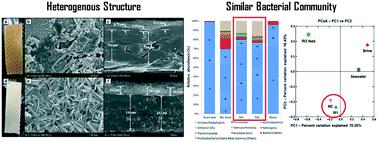当前位置:
X-MOL 学术
›
Environ. Sci.: Water Res. Technol.
›
论文详情
Our official English website, www.x-mol.net, welcomes your
feedback! (Note: you will need to create a separate account there.)
Structural heterogeneity yet high similarity of the microbial community on reverse osmosis membrane-driven biofilms during seawater desalination
Environmental Science: Water Research & Technology ( IF 3.5 ) Pub Date : 2020-09-11 , DOI: 10.1039/d0ew00366b Hyunjung Kim 1, 2, 3, 4 , Taeyoung Kim 1, 2, 3, 4, 5 , Azilah Abd Aziz 1, 2, 3, 4 , Donggeon Choi 1, 2, 3, 4 , Robert W. Lovitt 6, 7, 8, 9 , Dae-Wook Kang 10, 11, 12, 13 , In Seop Chang 1, 2, 3, 4
Environmental Science: Water Research & Technology ( IF 3.5 ) Pub Date : 2020-09-11 , DOI: 10.1039/d0ew00366b Hyunjung Kim 1, 2, 3, 4 , Taeyoung Kim 1, 2, 3, 4, 5 , Azilah Abd Aziz 1, 2, 3, 4 , Donggeon Choi 1, 2, 3, 4 , Robert W. Lovitt 6, 7, 8, 9 , Dae-Wook Kang 10, 11, 12, 13 , In Seop Chang 1, 2, 3, 4
Affiliation

|
Reverse osmosis (RO) membrane biofouling is a critical issue in seawater desalination. However, biofouling characteristics are not fully understood owing to the complex structure of the fouling layer. Therefore, the objective of this study is to investigate how the biofouling characteristics of RO membranes are associated with bacterial and archaeal communities and their physiological (surface structure, elemental composition, and thickness) and metabolic characteristics in different locations of the RO membrane element. Raw seawater, feedwater, first- and last-located RO membrane elements, and brine were collected from a full-scale (50 m3 per day) intermittently operated seawater reverse osmosis (SWRO) desalination plant. Bacteria were found to be the most dominant biofouling microorganism on the RO membrane surface rather than archaea or diatoms. This study highlights that the very first element of the RO membrane receiving inflow had fouled biofilm with more heterogeneous morphologies and chemical composition compared with the very last element of the RO membrane where the outflow is discharged. In contrast, the microbial communities in both biofilms were similar to each other during the period of desalination operation. The most dominant bacterial species in the biofilm of RO membranes were Pelagibius, Parvibaculum, Legionella, Hyphomicrobium, and Sphingomonas. Moreover, their physiological and metabolic characteristics, such as salt tolerance, high pressure tolerance, and/or oligotrophic properties may provide advantages for their adaptation and dominance in RO membrane biofilms. A substantial difference in microbial diversity was observed between the feedwater and RO membranes, suggesting that more attention should be given to the biofilm, rather than the feedwater, when investigating how biofouling is developed and eventually controlled.
中文翻译:

海水淡化过程中反渗透膜驱动生物膜上微生物群落的结构异质性和高度相似性
反渗透(RO)膜生物污染是海水淡化的关键问题。然而,由于结垢层的复杂结构,生物结垢特性还没有被完全理解。因此,本研究的目的是研究反渗透膜的生物污染特性如何与细菌和古细菌群落及其在反渗透膜元件不同位置的生理特性(表面结构,元素组成和厚度)以及代谢特性有关。从满量程(50 m 3)中收集原海水,给水,第一和最后放置的反渗透膜元件以及盐水每天)间歇操作的海水反渗透(SWRO)海水淡化厂。发现细菌是反渗透膜表面上最主要的生物污染微生物,而不是古细菌或硅藻。这项研究强调,与流出流出的RO膜的最后一个元素相比,RO膜的最开始接受流入的元素污染了具有更不均匀形态和化学成分的生物膜。相反,在脱盐操作期间,两个生物膜中的微生物群落彼此相似。在反渗透膜的生物膜最优势菌种是Pelagibius,Parvibaculum,军团菌,生丝微菌属和鞘氨醇单胞菌。此外,它们的生理和代谢特性,例如耐盐性,耐高压性和/或贫营养性,可为其在反渗透膜生物膜中的适应性和优势性提供优势。在给水和反渗透膜之间观察到微生物多样性的显着差异,这表明在研究如何形成并最终控制生物污垢时,应更加关注生物膜而不是给水。
更新日期:2020-09-11
中文翻译:

海水淡化过程中反渗透膜驱动生物膜上微生物群落的结构异质性和高度相似性
反渗透(RO)膜生物污染是海水淡化的关键问题。然而,由于结垢层的复杂结构,生物结垢特性还没有被完全理解。因此,本研究的目的是研究反渗透膜的生物污染特性如何与细菌和古细菌群落及其在反渗透膜元件不同位置的生理特性(表面结构,元素组成和厚度)以及代谢特性有关。从满量程(50 m 3)中收集原海水,给水,第一和最后放置的反渗透膜元件以及盐水每天)间歇操作的海水反渗透(SWRO)海水淡化厂。发现细菌是反渗透膜表面上最主要的生物污染微生物,而不是古细菌或硅藻。这项研究强调,与流出流出的RO膜的最后一个元素相比,RO膜的最开始接受流入的元素污染了具有更不均匀形态和化学成分的生物膜。相反,在脱盐操作期间,两个生物膜中的微生物群落彼此相似。在反渗透膜的生物膜最优势菌种是Pelagibius,Parvibaculum,军团菌,生丝微菌属和鞘氨醇单胞菌。此外,它们的生理和代谢特性,例如耐盐性,耐高压性和/或贫营养性,可为其在反渗透膜生物膜中的适应性和优势性提供优势。在给水和反渗透膜之间观察到微生物多样性的显着差异,这表明在研究如何形成并最终控制生物污垢时,应更加关注生物膜而不是给水。











































 京公网安备 11010802027423号
京公网安备 11010802027423号